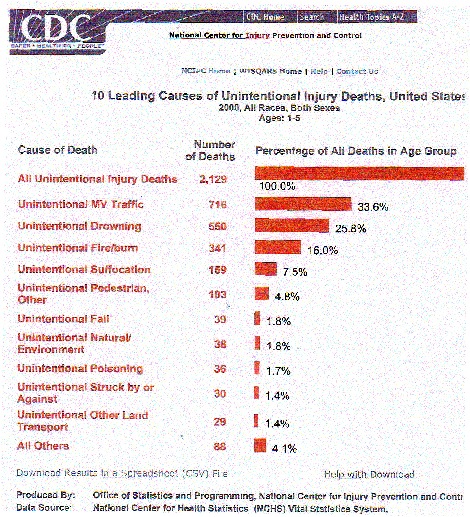|
SOPHIA
- 25
|
(Synopsis:
Terrorism takes many forms, but one of the most insidious for a parent is
the Terrorism created by water. Young children can drown in a
small amount of water. A phone call while a child is bathing
can create a tragic event if a child is left unattended.
Swimming pools are as dangerous as a suicide bomber climbing aboard a bus,
or Osama bin Laden strolling in the Rose Garden at the White House.
Vigilance can "water proof" the dangers created by the "Beast of Water
Terror." G-Ma Lori offers Parents, Grandparents and Loved One's of
Vigilance an incisive look at how to be Vigilant in the Water-Proofing of
the Children's Children's Children.)
WATER-PROOFING
THE CHILDREN
AGAINST THE BEAST OF TERROR
by
G-Ma Lori
“See,
Sarah, this is called the side stroke. I’ll show you the back stroke and
the breast stroke next.” I gasped out the words as I did my best to
demonstrate several swim strokes for my five-year-old granddaughter. I
haven’t seriously swum for years and found myself moving slowly through
the water like a tired sea lion. Swimming, I found, was like riding a
bike--one never forgets how. But I did find one flaw in that axiom--
one’s effort, agility and speed are altered with age.
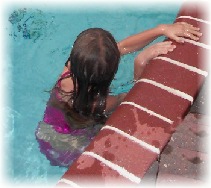 |
|
"Look at me G-Ma,
I can swim" |
“I can ‘crawl through the water’, G-Ma. I already know how to do
that. Let me ‘crawl’ to you.” Sarah, brightly attired in her two-piece
swimsuit, effortlessly slipped off her mermaid swim board like a sleek hot
pink otter into the shallower water. She grabbed onto the side of the
pool for safety.
“Wait for G-Ma to catch you, my little fish.” I paddled closer so
there would be less than ten feet between us. Every year Sarah’s Uncle
Bob generously invited Sarah’s family and his many other relatives to the
huge house he rented for a summer month in the Hamptons. It was an annual
event--a day of swimming and family fun followed by a delicious barbeque.
“Ready, set, here I come, G-Ma.” Sarah released her grip on the
side of the pool and moved toward me, her neck stretching and her chin
thrust upward completely out of the water. Her feet churned frantically
and her arms paddled like a little puppy floundering in a pond. Dog
paddling was most certainly an accurate name for her swim stroke.
“Look at me, G-Ma, I can swim. I can swim.” Sarah’s smile was as
wide as Jaw’s grin.
“You are doing so good, little missy. I’m so proud of you.” I was
excited for Sarah and her seven-year-old brother, Matt. Both of their
swimming skills markedly improved during these summer months.
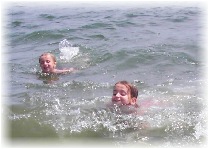 |
|
I was amazed at
how adept Matt and Sarah were riding the waves |
Two
summers ago, my older daughter stressed her desire for Matt and Sarah to
learn how to swim. Both children have been enrolled in YMCA swim
programs as well as the City Park summer programs for three years.
Matt appeared to have mastered swimming underwater and now Sarah was
successful at the ‘dog paddle’. They were well on their way to
learning to swim.
Last month, their mom, G-Pa (my husband) and I took the kids to
Brighton Beach. We were delighted by the absence of the usual New York
crush of beach goers, and blessed by fantastic weather. The grandkids
Daddy, an excellent ocean swimmer, had shown them during previous ocean
experiences how to dive into the waves and let themselves be carried to
the shore. I was amazed how adept they were at wave riding. They were
very alert to ocean dangers, both real and imagined. Little Sarah kept
telling me the small rocks disturbed by the tidal movements were sea
monster eggs.
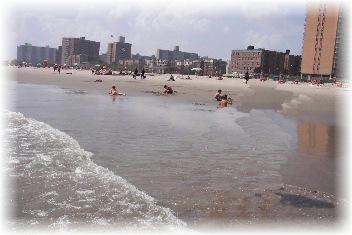 |
|
Last month we
enjoyed the wide expanse and absence of crowds at Brighton Beach |
“G-Ma, yikes, those t-h-in-g-s are still trying to bite my feet. Are
you sure there’s no monsters down there”? Sarah wouldn’t look down at her
feet for fear that I may have misinformed her. She seemed to like the
imagination that sea monsters were afoot.
“Oh, silly, Sarah. Sandy Beach will save you if you need help.”
Matt thrust out his bony chest, acting like a much smaller version of one
of his favorite Rescue Heroes, Sandy Beach, who is ready to make the sand
and surf safe for others.
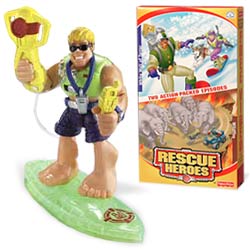
|
|
Sandy Beach was
one of Matt's favorite Rescue Heroes especially in the summer |
“Matt, can I be Bob Buoy?” Already the sea monsters were forgotten
as Sarah and her brother played Rescue Heroes. The Rescue Heroes rely on
positive human virtues and nonviolent problem solving. They are the
perfect toys for children to learn a moral message that underscore
concern, compassion and sensitivity for others. These virtues, they learn
from their Rescue Hero models, are not only admirable, but cool.
“G-Ma, did you surf when you lived in California?” Matt simulated
surfing on a surfboard he’d drawn in the sand.
Matt, Sarah, G-Pa and I sat on our towels watching a lone surfer
try to avoid the whistle and commands of the Life Guards. He was in a
‘for-swimmers-only’ area.
“Matt, I never was a surfer. But, your G-Pa was. He lived in
Hawaii and learned to surf there. His teachers were Hawaiians, the
original surfers. Back then, the boards were much longer and so it was
much harder to surf.”
“ Your Auntie ‘E’ and Mommy learned a little about surfing, but,
more importantly, they had a summer course on ‘ocean proofing’. I gently
kicked up some sand onto Matt’s toes, trying to cover them.
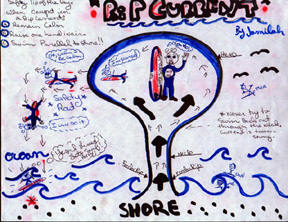 |
|
My daughters took
a course in 'ocean proofing' to be more competent and safe swimming in
the ocean |
“G-Ma! Quit that. Sarah’s the one who always wants to be buried.
Not me.” Matt indignantly squealed.
“G-Ma, I want to know what is ‘ocean proofing’. What is that?”
Sarah’s question diverted Matt’s attention.
“It’s simply a safety class on knowing about the ocean. It teaches
you about the dangers of the ocean and how to be safe in the water – so
that your mommy and your aunt wouldn’t drown or be afraid of the water
……or worry about all the sea monsters that are carried in by the waves
that attack little girls’ toes.” I grinned widely.
“G-Ma, you said there weren’t any sea monsters in the water. Are
they only in California oceans?” Sarah’s brows drew together like the
arms of a starfish dried out and shriveled on the beach.
“Sarah, G-Ma’s only teasing you. There aren’t any sea monsters
here but there are…S-H-A-R-K-S!!!!” Matt leapt up, scattering sand
everywhere. He opened his mouth as wide as possible and pretended to bite
at his now terrified little sister.
“Matt, calm down. There aren’t any sharks in these waters.” I
patted the empty towel space he abruptly vacated like a frog leaping off a
lily pad attacking a juicy fat fly.
“No, G-Ma there ARE sharks in the waters around New York and
New Jersey. The bull and lemon sharks live in our waters. They haven’t
bitten anybody yet…but they are looking to
bite….a….little….girl….named….Sarah.” Matt charged up and once more with
his teeth barred toward Sarah.
 |
|
Matt charged at
Sarah barring his teeth like a shark in the area's waters |
“Matt, that’s enough. Sarah, nobody in our waters has been
attacked. Matt is exaggerating. Right, Matt?” I stood and started the
process of trying to de-grit myself after Matt’s latest attack that
showered sand everywhere.
“Well, there ARE sharks here. I saw them on Discovery
Channel. Swimmers are supposed to be extra careful and not swim out too
far. Sarah if you see one in the water, you are supposed to be very
still and they won’t bite you. Also, we should swim in a group and that’s
lots safer I heard on the show.” Matt strutted around looking much like
a miniature professor, a thin one, of course, and wearing a swimsuit and
sunscreen.
“Well, I’m not going in by myself. I
know that, Matt. Even in swimming pools I don’t go in by myself.
We have the buddy system in our family. And I have lots of buddies.
I have mommy, daddy, G-Ma, G-Pa, Auntie ‘E” – so………I’m not afraid of the
water. I’m water-proofed, right G-Ma”.
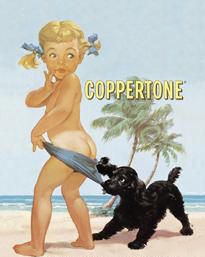 |
|
My grandkids were
as brown as the children in the suntan lotion ads |
“Right you are, little seal.”
I pulled my tanned granddaughter up to stand alongside Matt and me.
With their sun bleached hair and healthy glow of their copper-tone tanned
skin, they looked like commercials for sun tan lotion.
Their mom was underneath the makeshift beach
umbrella feeding Angus, their fourteen-month-old brother. Angus loved the
water even more than his older brother and sister. Besides eating the
sand, he tried to catch the foamy bubbles the tide carried to and fro.
He was a real sea urchin, fearless and eager to have the waves lap and
swoosh around him.
Before arriving at the beach we all discussed ‘beach proofing’ so
Angus would be safe. We all vowed to be Beach Sentinels of Vigilance.
We agreed that Complacency was the worst enemy of Vigilance on the
beach. Complacency would be not paying attention, or assuming some one
else was watching Angus. We all agreed to be in charge of safety, just
like the Rescue Heroes chant: “Think Safe!”
Angus is a sturdy bulldog, tanned, blue-eyed, towheaded and very,
very fast. His cries of glee sound like little yelps of pleasure as he
races pell-mell into the surf. Matt and Sarah took turns helping either
their mom or me with the exhausting task of watching his every move. Too
many tragic accidents happen when people think another person is watching
a child. We had a genuine ‘Angus Watch’ system set up. We were all
Rescue Heroes of Vigilance.
At home, whenever the bath water is drawn for ‘tubby time’, Angus
races to the bathroom and several times has almost toppled over into the
bath water with his clothes on. Only vigilant care whenever the bathroom
door is opened prevents an accident.
Drowning is often called the ‘silent killer’ of youth since children
rarely splash or call out. Even a few minutes of inattentiveness can mean
the difference in saving a child or not. Not all children consider
learning how to swim an exciting and fun rite of passage. Most
children’s only experience with water is in the bath.
After hearing my daughter’s wish to have her children learn to
swim, I Googled my favorite search engine
www.google.com and gleaned some facts from the National Safe Kids
Campaign: 1.) In the time it takes to cross the room for a towel (10
seconds) a child in the bathtub can become submerged; 2.) a child can lose
consciousness in the time it takes to answer the phone (two minutes); 3.)
very young children can drown in as little as one inch of water, thus,
they are at risk of drowning in wading pools, bathtubs, buckets, toilets,
spas and hot tubs.
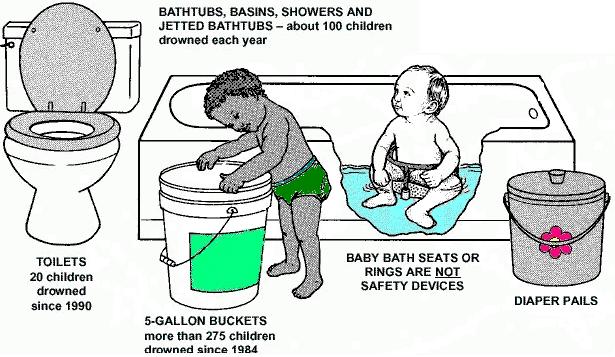 |
|
Facts from the
National Safe Kids Campaign are startling |
I also found some other startling but important information.
According to the National Center for Health Statistics, children aged 5-14
most often drown in swimming pools and open water such as rivers, lakes,
dams and canals. Children who drown in residential pools had been last
seen inside their home. Most had been gone for less than 5 minutes, and
in the care of either or both parents at the time. Residential swimming
pools account for 60-90% of drownings for children aged 0-4. Half of
these drownings occur at the child’s own home.
Nineteen percent of drowning deaths involving children occur in
public pools with certified lifeguards present. For every child who
drowns, four are hospitalized for near drowning. An estimated 5,000
children ages 14 and under are hospitalized due to near-drownings each
year; 15% die in the hospital and as many as 20% suffer severe, permanent
neurological disability. Drowning is the 4th leading cause of
accidental death in the United States, claiming 4,000 lives annually.
Approximately one-third are children under the age of 14. Drowning is the
second-leading cause of unintentional, injury-related death among children
under the age of 15.
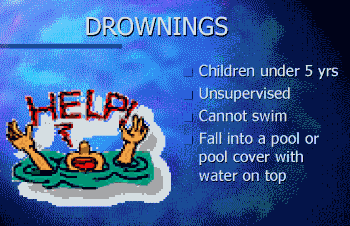 |
The Center for Disease Control states in the year 2000, 943 children
ages 0-14 years died from drowning. While drowning rates have been
declining slowly over time, it still remains the second-leading cause of
injury-related death for children ages 1 to 14.
In a nutshell, all this information simply meant that water equaled
Terror for those who weren’t Vigilant. I elected myself to be the
Grandmother of Water Proofing Vigilance, and deputized Matt and Sarah,
G-Pa and my daughter. After all, someone has to be in charge!
Most children's earliest experience with water is
in the bath. Some of the following milestones toward swimming
readiness can begin in the tub, as well as in a pool, lake or ocean.
I found a simple yet detailed list from
www.parenthood.com for
parents on "Helping Kids Learn to Swim Safely". Let you child master
the steps to swimming, in a logical sequence, one step at a time by:
1. Getting the face wet. Blow bubbles in the
water or blow ping-pong balls across a tub or kiddie pool.
2. Learning to duck under water. First, let your timid
tot select an underwater doll or duck. Then, tell her to take
a breath and hold it while submerging her toy. When she needs
to breathe again, tell her to raise the toy. Try this first
without putting her face into the water. Then slowly, playing
the game together, encourage her to hold the toy underwater while
hoe goes under, too. Then, tell her to let it pop up to the
surface as she comes up for air.
3. Learning to lie across the water to swim. Children
tend to curl up in the fetal position, which causes them to
sink. Have your child flatten his or her body and feel how his
or her body works under water. You can demonstrate this
principle to your child by holding an empty plastic-gallon milk
container (with cap on) in each hand. The containers will help
keep the child's face above water while she learns to relax his or
her body across the water's surface. (water wings if not
overly inflated will work, too).
4. Learning to stroke. Use an inflatable raft or
windsurfing board (no sails) to help 'nearly swimming' children get
a feel for pulling the water for propulsion. Position your
child on her stomach at the very front and encourage her to paddle
with alternating arm pulls and the double-arm action. Stress
the use of strong, slow strokes to learn to "glide."
5. Jumping into the water. Hold a hula hoop vertically
or horizontally above the surface of the water and entice children
to ump through the hoop from the side of a pool or dock.
6. Getting the knack of floating. If you're at the
beach, have your child lie on his or her stomach in hallow water and
put his or her hands in the sand to maintain a sense of control.
Facing the shore, the child should stretch his or her legs
fully behind, which gives a sense of buoyancy and offers quick
recovery to a weight-on-hands position. Next, add the kick and
a few paddling motions. When ready for the final challenge
have your child put his of her face in the water while paddling and
kicking.From waist-deep water, your child can "lunge" forward in a body-surfing action, with hands reaching forward and to
the bottom.
Keeping your lungs inflated helps you to float, either prone or
on his or her back. Let your child "dribble the basketball" to
demonstrate this concept. Fill your lungs with air in shallow
water, curl into a floating "ball" and have your child push you down
gently each time you
bounce" back up to the surface.
7. Diving under water. Throw bright, weighty objects
into the water for children to retrieve.
|
|
"Helping Kids To
Swim Safely" from
www.parenthood.com
|
Then I thought about all the people who took
their children or grandchildren or other people’s children to the water.
I thought it might be good to offer them some Vigilant Water Proofing
information. Here are some interesting tips I found from the web on
helping teaching kids how to swim:
I took the job of Grandmother of Water
Proofing Vigilance after my daughter confided her anxiety about teaching
her children to swim. She was like the surgeon who didn’t want to
operate on his or her own family. I was happy to take on the
responsibility.
I thought about my own experiences learning to swim and how
G-Pa and I taught her and her sister to swim. Before our beach
adventure, I shared the experience with Matt and Sarah.
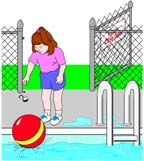 |
|
When my daughters
were younger we employed Pool Vigilance and experienced no Pool Terror |
“Sarah and Matt, your mommy took a swimming class when she was
younger than you did when you went to the Y. She was close to Angus’
age. The class was called Mommy and Me.”
“G-Ma, G-Ma, did mommy learn to swim there? Was that in San Diego?”
Sarah’s trill Voice rose an octave in her effort to out yell her brother.
“You know, little ones, all mammals can swim. Even cats. So, you
two little spotty leopards for sure can swim. And, yes, we lived in San
Diego. Your mommy didn’t learn how to swim that summer, but the class was
a good start for her. She became comfortable in the water.”
We were at home in my apartment. I cozied up to my little ones on
our small couch looking like a momma otter with two squiggly little ones
on either side waiting for a treat.
“Did momma blow bubbles in the water like we did at my classes?”
Matt grimaced as he asked. “I thought I looked like a girl when I did
that. I didn’t enjoy it one bit.” Matt grumbled.
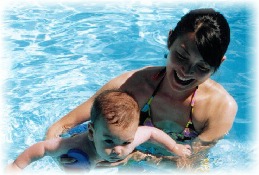 |
|
'Mommy and Me'
swim classes are offered in many places |
“Hmm…. That does remind me of what did happen on one morning at
class.” I laughed and continued. “I was emphasizing the bubble blowing
for your mommy when I had to suddenly yank her up and out of the water.
Can you guess why?”
“There was a bug in the water,” screeched Sarah. “That’s why mommy
had to get out of the water.”
“No, it was a great big…terd. It looked like a brown log floating
down a river. But, this was a swimming pool and it wasn’t a log. I
didn’t want her to get it on her lips as she was blowing bubbles near it.”
Both kids yelled out “Blaghhh…….Yuck….Yuck…..G-Ma…..how gross.”
“It’s a good thing we have improved swim diapers today. The water
is more hygienic and pool keepers don’t have to worry about Angus’ or
other kids’ waste in the water. I don’t think your mommy remembers that
experience at all, but I will never forget it.”
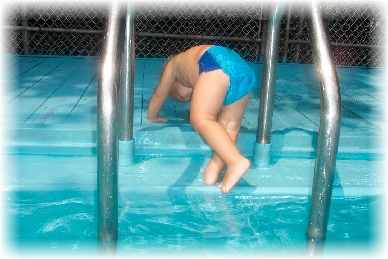 |
|
Disposable swim
diapers prevent accidents of a different nature in the swimming pool
|
Sarah and Matt didn’t think the story was that funny, but hints of
smiles appeared on their faces.
“Mommy said you had your own swimming pool. Wow, that was cool.”
Matt’s glistening blue eyes reminded me of the Southern California sky.
“Yes, we did. We were a careful family and never had a swimming
accident in our pool. We were Vigilant in teaching pool safety as well as
skill development. Your mommy and Auntie ‘E’ were in the water at least 3
or 4 hours each day during the summer. Until they were older, G-Pa or I
were always on alert to make sure they were safe.”
“I wish we had our own pool, too, G-Ma. But, at least Mommy had us
take lessons and we have the beach, Pitt Street and Tompkins Park pools to
use. I like to swim and I can be like Sandy Beaches and save those who
need help.” Matt, picked up his cardboard surfboard he’d made and
pretended to wade into water.
“Hey, Dude, let’s surf.” He thumbs-upped Sarah hoping to get her to
play Rescue Heroes again.
 |
|
"Dude, I know how
to be careful in and around water. I'm 'water-proofed'. |
“Copy that, dude. G-Ma, I’m going to be careful. I know it is
important to be safe in the water – the pool and the ocean. I’m
‘water-proofed’, that’s what I am. I want to rescue people some day like
the lifeguards and Rescue Heroes. I’m already a good swimmer for how old
I am. Mommy and daddy and you made sure of that.”
I was glad the summer proved the ability of the kids to swim. I was
even happier that we had “water proofed” the grandchildren with swimming
skills and safety lessons.
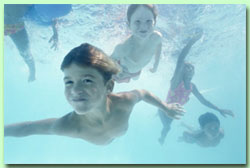 |
|
Now both
Matt and Sarah are competent in the water |
Sarah now swims on her back like a pro – and while on her tummy,
she’s not afraid to get her face wet anymore. Matt still prefers
underwater to move any distance, but can half dogpaddle, half crawl when
he has to. They both are competent in the water.
Their mom and dad are proud and
relieved a goal has been attained. But there was another benefit of
waterproofing that can’t be overlooked.
The close physical contact that occurs between parents and
children in the learn-to-swim process nurtures the development of family
bonds. It creates a Vigilance Bond between child and parent. Matt and
Sarah’s parents are Sentinels of Water Vigilance. They know that their
children’s early mastery of water is critical to their safety, and equally
as important as learning to walk. All Parents and Loved Ones of Vigilance
need to be aware of the importance of ‘water-proofing’ their children.
Complacency might lead to drowning or water-related accidents that can be
avoided.
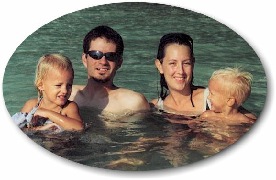 |
|
Teaching children
to swim creates a Vigilant Bond between parent or loved one and child |
Babies can even be taught to swim. Babies originate from the
watery environment of a mother’s womb, and so arrive in the world
inhibition free and without inbuilt fears of water. The sooner the
‘lessons’ begin, the better. At this stage babies have not been
pre-conditioned to fear water, therefore the introduction to an external
water experience, will, if patiently and lovingly conducted represent a
pleasant and natural experience for your child.
Be a Sentinel of Water Proofing Vigilance. Don’t let Terrorism
spoil your ability to have fun in the water.
Water-proof your loved ones with Vigilance. You’ll be glad you did.
Go
To Sophia 26: Rule 62 And Vigilance Activities
|
©2001
- 2004, VigilanceVoice.com, All rights reserved - a ((HYYPE))
design |
















